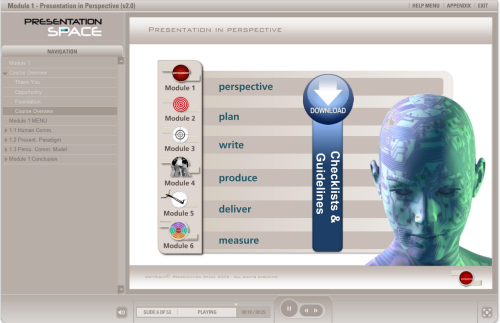The Science of Effective Presentations: Customer Demo
Warwick Burgess, Director at Presentation Space, is an Articulate customer who understands the importance of an effective presentation: The Australian company has studied the science of it, including the impact on the human brain.
![]() Creating and delivering content with Articulate Studio ’09 is an integral part of how Presentation Space trains its customers — which include companies like American Express, Clorox Australia, and Wyeth Australia — to become better speakers and presenters.
Creating and delivering content with Articulate Studio ’09 is an integral part of how Presentation Space trains its customers — which include companies like American Express, Clorox Australia, and Wyeth Australia — to become better speakers and presenters.
Presentation Space practices what it preaches and has done an excellent job leveraging Articulate tools to create online content that engages its audience.
Sample Course
This condensed version of the company’s Module 1 training course, according to Warwick, outlines “the importance of using sensory information and emotion to maintain audience attention:”
View Presentation Space Module 1 Demo
Some highlights of this course that really make it shine include the following:
- Excellent audio quality
- Professional graphics and imagery
- Customized player template
- Great use of animations
- Good content organization via levels feature
- Integrated help menu via an Engage Tabs interaction in the toolbar
Interview with Warwick Burgess
I asked Warwick a couple questions about his experience using our software:
 Why do you use Articulate Products?
Why do you use Articulate Products?
My background is in marketing and multimedia production. We came across Articulate searching for the best production tool to produce a comprehensive presentation skills eLearning course. When compared with the complexities of programming and producing a course using other software programs, we were delighted with the efficiency and cost-effectiveness of the complete Articulate solution. We’re also using Articulate increasingly to produce and deliver short promotional presentations for both ourselves and clients.
What are your favorite Articulate features?
We use the majority of the Studio ’09 products and features. We found the branching options and the Hide in Navigation Panel feature added significantly to the navigation options, and there were a number of productivity improvements in the ’09 versions that have enhanced our production efficiency.
So next time you’re creating elearning or delivering a presentation, consider the physiological impact your delivery may be having on your audience.


15 responses to “The Science of Effective Presentations: Customer Demo”
The production value of this presentation is impressive, certainly well above the run-of-the-mill powerpoint-based presentations I am accustomed to. I was particularly imnpressed by the visuals and custom skin, as you highlighted in your post. I opened the demo with the intent of just soaking in the layout, but ended up viewing it in its entirety for the information – I cannot think of a better measure of effectivenes than that.
The comments within the demo relating to typical presentation approaches taken my managers/execs (cram in as much text as possible!) were spot on.
And I think I need to find a Australian to do our future voice-overs.
Glad you liked this course, Terence! I also dig the Australian accent in the voice-over.
[…] The Science of Effective Presentations: Customer Demo – Articulate – Word of Mouth Blog http://www.articulate.com/blog/the-science-of-effective-presentations-customer-demo – view page – cached * Check out the winning entries from the 2009 Articulate Guru Awards * Open enrollment training now available for Studio ’09 — From the page […]
I also enjoyed the course. I wonder what software and compressions settings he used to get such great-sounding audio?
Gabe,
Though I agree with much that is said in the presentation–I also have a somewhat opposite view that can balance the graphic fundamentalism that elearning design has fallen into 😉
You can check out this blog entry on treating text as images:
http://www.42designsquare.com/elearning-blog/?p=61
Hi this is Warwick from Presentation Space.
If I think I can add any value to the discussion I’ll respond to each comment individually.
Firstly to JENNIFER. Thank you for your feedback;
– The secret to good quality sound is in the recording. We had the luxury of using a sound studio & a professional voiceover artist for this job.
– That said, we also used the “Custom” quality setting within Articulate. The audio quality was increased from 32 to 40 kbps with the Image compression reduced from .75 to .60 to avoid any slowdown in download speed. If you’ve recorded voiceover on your PC, I’d try testing the sound quality at 48kbps or higher with an image compression setting that you’re happy with.
Warwick again,
Hi ABHINAV PATIL & thank you for your very relevant feedback.
I would ask that you view our communication in the context of presenters and presentation audiences and therefore our need to practice what we preach with the visuals we use.
For eLearning applications or online presentations, where the audience is in front of a PC screen, I agree that you can increase the amount of text or information on a visual screen, as long as you give your audience time to process the information, before you speak to it.
Even with live presentations, we’re not suggesting you do away with text or detailed information altogether. There has been a trend towards using just pictures in business presentations which we also believe is going too far the other way.
Our key messages to presenters’ on the use of text on support visuals are:
– Mix it up. Use bullet points to make important points but don’t use too many text screens in a row.
– Show detailed charts, tables, graphical or statistical information if it gives your audience a big picture overview or it supports the credibility or authenticity of the material (showing actual data or scanned image of it for example). If you refer to the detail then “zoom in” on it. Use a separate visual with just the key information or numbers on it, to emphasize your point.
– One of the greatest challenges is to find the right substance or detail to present within the time available. We strongly believe that if you lose an audience on a sensory or emotional level, then they will not absorb or retain the detail anyway. We believe that it is more important to engage and involve an audience than attemping to communicate too much information. Additional information (support documents or research in a print or digial format) should always be available to those that are interested, following a presentation.
The bottom line, for any communication, is that there must be a balance between engaging and involving your audience and the substance, sophistication or level of detail you provide.
Warwick- your comment here:
“Use a separate visual with just the key information or numbers on it, to emphasize your point.”
…reminds me of this recent blog entry on the topic from The Rapid eLearning Blog: Try These Tips for Great-Looking Charts.
Warwick,
I couldn’t agree more with everything you’ve written. I appreciate your detailed response.
Personally, I would rely more on interactivity to evoke emotional involvement without underrating the need for presentation to engage the learners. I’m a big fan of Articulate Quizmaker and its free form authoring capabilities.
Great presentation…Question, your images are so clear and crisp and we all know that images on slides in Presenter blur the minute you publish them…Are you using swf movies on all powerpoint slides to get such crisp images?.
Hi Chris- I’m sure Warwick will have some input, too, but did you know that the publishing engine in Presenter ’09 was completely rebuilt? You should see high-quality images now. Here’s a blog entry you might find helpful: How to Get Perfect Screenshots in Presenter ’09.
Hi Chris, Gabe has covered the most important issue relating to the superior image quality you get when you publish through Presenter ’09. It is also worth reading the link about image sizes and scaling, however you may find the comments on the DPI of an image and the effect this has on scaling within PowerPoint a little confusing.
I think the simple solution to image quality is… when you’re working within PowerPoint, go to the menu View/Zoom/100%… if it looks good then then it will look good when published through Presenter ’09. (Without trying to confuse you… an image at print resolution, say 300 dpi, can be scaled significantly higher than 100% in PowerPoint and still be clear & crip)
With several hundred images to manage within our training, I do have other suggestions to make:
– We work with all our images at screen resolution (72 dpi). This reduces the physical file size of the image and displays it within PowerPoint at the correct size/scale percentage.
– We never scale an image saved at 72 DPI above 100% but often scale it downwards. It’s just too hard to have every image at 100%. We therefore save images at the maximum size we would ever use them & scale them down for design or layout reasons if needed.
– There are some exceptions to scaling. For example an images that includes text is best displayed at 100%(not scaled at all)
I hope that helps?
Indeed very good course! I would like to know how did u integrate Engage interactivities as Help menu and Apendix on the toolbar? Thanks.
Hi SHEETAL,
I’ve been travelling for couple of weeks and applologise for the slow response.
Within Engage you can choose to Publish the file as an independent Engage project or to integrate it into an existing Presenter project (the name of the Engage interaction will then appear in the “menu/toolbar” of the Presenter file you nominate).
Regards
Certainly a great step forward in both learning process and methodology however as someone who has worked very closely with Whole Brain Thinking practices for many years from what I have seen so far is the fact that the dominant thinking style of the presenter despite the best presentation framework will always come through one way or another
Often presenters do not know what their dominant style is and the impact that this has upon people of varying preferences, getting the right mix is the real trick as people are just glad to simply survive yet another meeting
To add to this it is often difficult for presenters to be able to break away from the established and preferred styles of corporate presentations which we know are data, text and graphically dense. Or they are presented in such away that it helps to reinforce what they wish to sell and this is often trapped in the delivery of simple product features and in some instances it is framed with a range of supporting advantages for the buyer.
We are missing a whole lot here in the way that people wish to communicate and how people wish to be communicated too. I would suggest that a nice value add to this would be the inclusion of some further diagnostics or insights into the presenters thinking preferences.
Changing the dialogue is more than swapping one process for another, there has to be some personal awareness of why people should change not matter how immutably obvious it is that they should
Food for thought, happy to discuss this matter further at length, well done guys.
cheers
Leigh
Comments are closed on this post. Need more help? Post your question in the E-Learning Heroes Discussions.